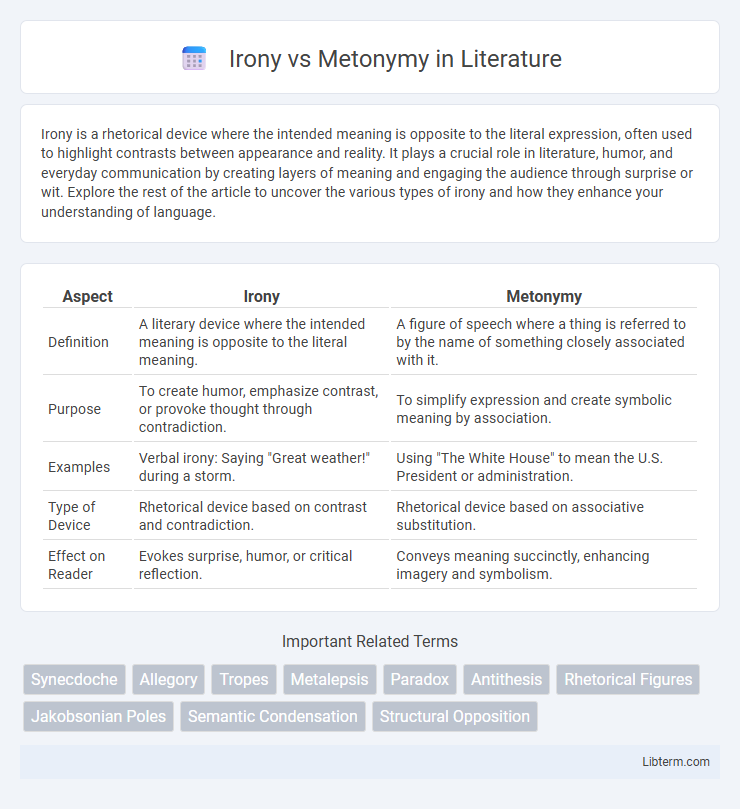Irony is a rhetorical device where the intended meaning is opposite to the literal expression, often used to highlight contrasts between appearance and reality. It plays a crucial role in literature, humor, and everyday communication by creating layers of meaning and engaging the audience through surprise or wit. Explore the rest of the article to uncover the various types of irony and how they enhance your understanding of language.
Table of Comparison
| Aspect | Irony | Metonymy |
|---|---|---|
| Definition | A literary device where the intended meaning is opposite to the literal meaning. | A figure of speech where a thing is referred to by the name of something closely associated with it. |
| Purpose | To create humor, emphasize contrast, or provoke thought through contradiction. | To simplify expression and create symbolic meaning by association. |
| Examples | Verbal irony: Saying "Great weather!" during a storm. | Using "The White House" to mean the U.S. President or administration. |
| Type of Device | Rhetorical device based on contrast and contradiction. | Rhetorical device based on associative substitution. |
| Effect on Reader | Evokes surprise, humor, or critical reflection. | Conveys meaning succinctly, enhancing imagery and symbolism. |
Introduction to Irony and Metonymy
Irony involves expressing a meaning opposite to the literal interpretation, often highlighting discrepancies between appearance and reality to create humor or emphasize a point. Metonymy substitutes a word with another closely related term or concept, such as using "the crown" to refer to royalty, enhancing vivid and concise communication. Both rhetorical devices enrich language by engaging readers through indirect and imaginative expression.
Defining Irony: Key Characteristics
Irony involves expressing meaning by using language that normally signifies the opposite, often to highlight contradictions or emphasize a point. Key characteristics include incongruity between expected and actual outcomes, a contrast between literal and intended meanings, and the presence of subtle humor or sarcasm. Unlike metonymy, which substitutes related terms, irony relies on oppositional logic to convey its effect.
Understanding Metonymy: Essential Features
Metonymy involves substituting a related concept or attribute to represent something else, such as using "the crown" to refer to monarchy or royal authority. It relies on an associative relationship between the term used and the concept it signifies, grounded in contiguity rather than contrast. Understanding metonymy requires recognizing these intrinsic connections, which differ from irony's reliance on oppositional or contradictory meanings.
Irony in Literature and Everyday Language
Irony in literature often serves as a powerful tool to convey meaning opposite to the literal expression, creating layers of complexity and engaging readers through contrast and unexpected outcomes. In everyday language, irony manifests through sarcasm and situational contradictions, enriching communication by highlighting disparities between appearance and reality. Unlike metonymy, which substitutes related terms to represent an idea, irony relies on context and intention to reveal hidden truths or critiques.
Metonymy in Communication and Texts
Metonymy functions as a powerful linguistic tool in communication and texts by substituting a related term to represent a concept, enhancing clarity and brevity. It allows writers and speakers to evoke broader contexts and associations, such as using "the crown" to signify royalty or authority. This figure of speech enriches narratives and discourse by tapping into shared cultural knowledge, making messages more vivid and impactful.
Core Differences Between Irony and Metonymy
Irony involves expressing a meaning opposite to the literal interpretation, often to highlight contrast or humor, while metonymy substitutes a related term or concept to represent something else, such as using "the crown" for monarchy. Irony's core purpose is to create discrepancy between expectation and reality, whereas metonymy relies on associative relationships to convey meaning efficiently. Understanding irony requires recognizing contextual contrasts, whereas metonymy depends on cultural or conventional knowledge linking the substituted term to the original idea.
Functions and Effects of Irony
Irony functions by expressing meaning through contradiction between appearance and reality, often highlighting human folly or social critique with subtlety and wit. Its effects include engaging the audience's critical thinking, creating humor, and providing depth to communication by allowing multiple interpretations. Metonymy, in contrast, replaces a concept with a related term, focusing on associative meaning rather than irony's contrastive and evaluative functions.
Significance and Uses of Metonymy
Metonymy plays a significant role in language by substituting a word closely related to a concept rather than using the concept itself, enhancing clarity and vivid imagery. It is commonly used in literature, rhetoric, and everyday speech to create strong associative connections, such as using "the crown" to represent monarchy or "the White House" for the U.S. executive branch. This figure of speech simplifies complex ideas and adds depth to communication by evoking broader meanings through a single term.
Common Misconceptions: Irony vs Metonymy
Irony is often mistakenly confused with metonymy due to both involving indirect expression, but irony relies on the contrast between literal and intended meanings, while metonymy substitutes a related term to represent something else. Common misconceptions arise when people interpret metonymic phrases, like "the crown" for royalty, as ironic statements, which they are not. Clarifying that irony conveys a discrepancy or unexpected outcome, whereas metonymy functions through associative substitution, helps differentiate these rhetorical devices accurately.
Conclusion: Choosing Irony or Metonymy
Choosing between irony and metonymy depends on the communicative goal and the desired cognitive effect on the audience. Irony creates contrast between expectation and reality, fostering critical thinking and emotional engagement. Metonymy relies on association and context to convey meaning efficiently, enhancing clarity and conceptual connections in discourse.
Irony Infographic

 libterm.com
libterm.com